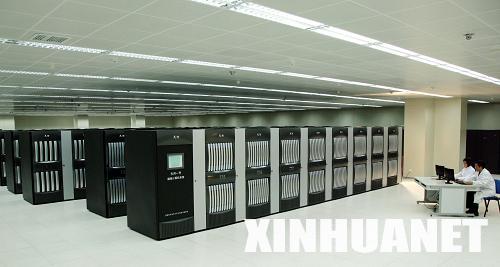China has built the world's fastest supercomputer, the Tianhe-1A, which is capable of 2.57 quadrillion computing operations per second, pulling ahead of the United States in the global supercomputing race.
 |
| File photo of China's world-leading supercomputer, Tianhe-1A. (Xinhua File Photo) |
The lead of the China-made system was officially confirmed by the 36th edition of TOP500 list of the world's most powerful supercomputers, which was released Monday on the TOP500 list website.
The Tianhe-1A was followed by the former No. 1 system, the U.S.-made Cray XT5 "Jaguar" at the U.S. Department of Energy's Oak Ridge Leadership Computing Facility in Tennessee.
The Jaguar system performs at 1.75 quadrillion operations per second, 92 percent slower than Tianhe-1A, running Linpack, the benchmark used to officially determine the speed of supercomputers.
The Tianhe-1A is installed at the National Supercomputing Center (NSCC) in north China port city of Tianjin, which specializes in super computing outsourcing services for complex work like the surveying of mines, the forecasting of weather, the design of high-end machinery, bioinformatics and large-data animation design.
Animation and biomedicine companies were queueing to book the services of the machine, said NSCC Tianjin Director Liu Guangming, who is heading for the U.S. to receive the certificate Tuesday.
Tianhe-1A's chief designer, Yang Xuejun, said in an exclusive interview with Xinhua, "The interconnection between CPUs and GPUs is key to the system's high performance.
"As there have been no precedents to integrate GPUs into a system for high-performance computing, we made much effort to improve the performance and efficiency of those GPUs," Yang said.
Another China-made supercomputer, Nebulae, which is a 1.27 petaflop-per second system, holds the third place on the TOP500 list.
Nebulae, developed by Dawning Information Industry Co., is equipped in a Shenzhen NSCC.
Jack Dongarra, a member of the U.S. National Academy of Engineering and supervisor of the TOP500 list, said in an e-mail interview with Xinhua, "It's more of a sign that China is serious in pursuing high performance computing to aid the growth of science, engineering and economic competitiveness.
"The long-term implication for the U.S. is that China is seriously interested in high performance computing, and is developing and deploying computing resources," said Dongarra, who leads research at the Oak Ridge National Laboratory.
Li Nan, the project manager for Tianhe-1A, told Xinhua, "We managed to upgrade key technologies, such as large-scale integrated chips, node computers and cutting-edge circuit boards. We also made a few breakthroughs in hybrid architecture and high-speed interconnection."
Of the world's 100 most powerful supercomputers, China has five while the United States has 42. Of the top 500 list, China-made systems number at least 45.
Tianhe-1A is estimated to have cost 600 million yuan (90.4 million U.S. dollars) and was developed by the Changsha-based National University of Defense Technology. It employs 14,336 Intel Xeon X5670 CPUs and 7,168 NVidia Tesla M2050 GPUs, as well as 2,048 home-grown Feiteng 8-core CPUs.
Zhang Yunquan, a leading computing scientist at the Chinese Academy of Sciences, told Xinhua, "The international supercomputing competition is extremely fierce and it's very difficult for China to hold the top position for more than one year."
Zhang Zhe, a researcher who works at the Oak Ridge National Laboratory, said, "Although the computing power of Tianhe-1A has surpassed Jaguar, its storage is not keeping pace."
Jaguar adopts an external file system with 10 petabytes, or 10 quadrillion bytes, of information storage capacity, while Tianhe-1A is only two petabytes.
The U.S. National Center for Supercomputing Applications (NCSA) is developing the IBM latest chip-powered Blue Waters system, which is widely believed to be the world's No. 1 by 2012.
INNOVATION STILL WEAK
Despite the achievement of Tianhe-1A in China's supercomputer development, experts say China still lacks innovation and has a long way to go in invention and creation.
"Its CPUs and GPUs were from the U.S., the former by Intel, and the latter by NVidia," said Dongarra.
Qian Depei, team leader on the high-performance computer project of China's national high-tech development project initiated in March 1986, known as Program 863, said China was still weak in technologies of central processors, system software and computing methods.
"To turn the supercomputer into a powerful tool spurring productivity, we have to plan for the future, and try all out to innovate," Qian said.
Dhabaleswar Panda, a leading professor of computer science and enginnering at the Ohio State University, said supercomputing always required cutting-edge technologies.
"If a country X will be able to provide sustained research funding for a long duration of time for supercomputing, this country X will eventually be able to take a lead in the area of supercomputing," he said in an email interview with Xinhua. (Xinhua)
Related News
Photos
More>>trade
market
finance
- Delegation Led by Minister Pinkwart from German State of North Rhine-Westfalia
- CAS Researcher Publishes Book on Marine Biogeochemistry in China Marginal Seas
- SCBG Conducts International Strategic Review and Designs for the Future
- AMS02 to Lift off Next July
- CAS President Gives Speech at Fourth World Science Forum





